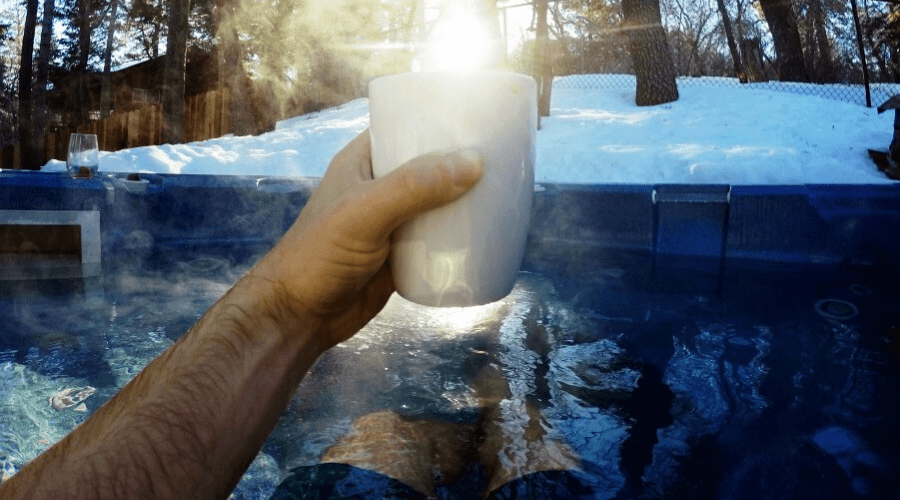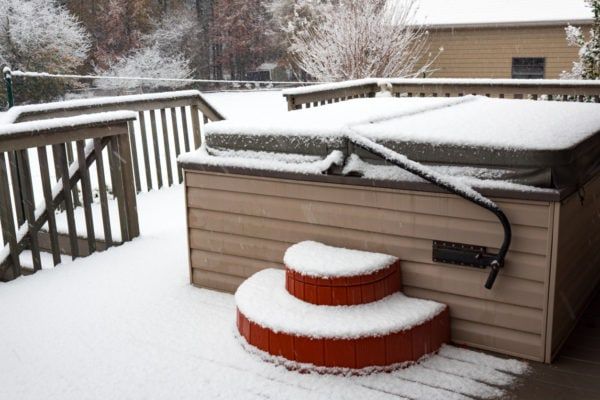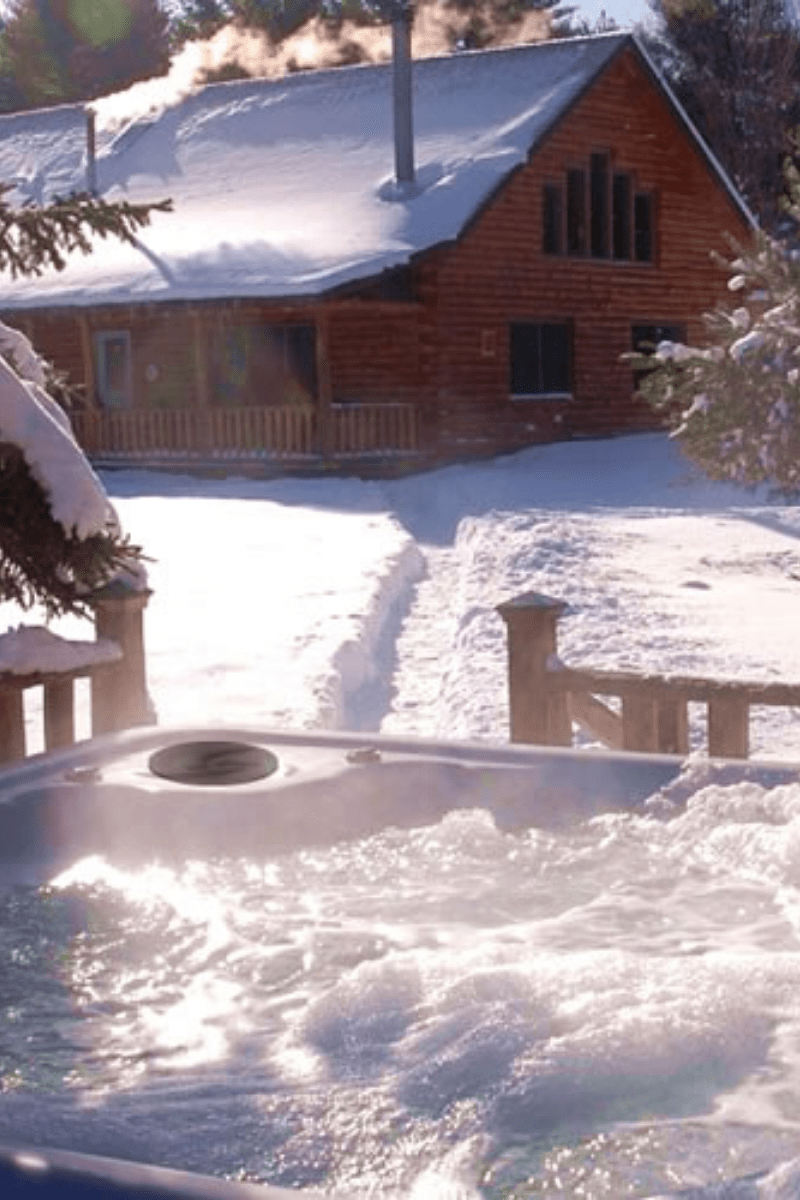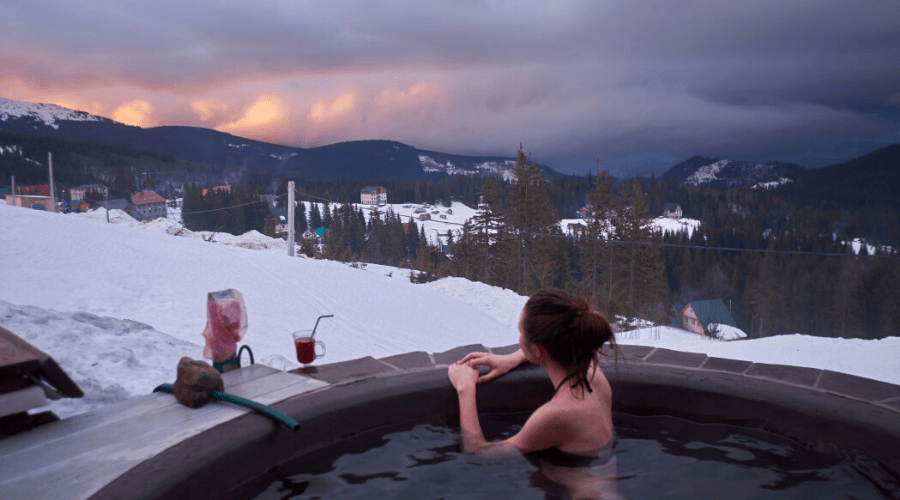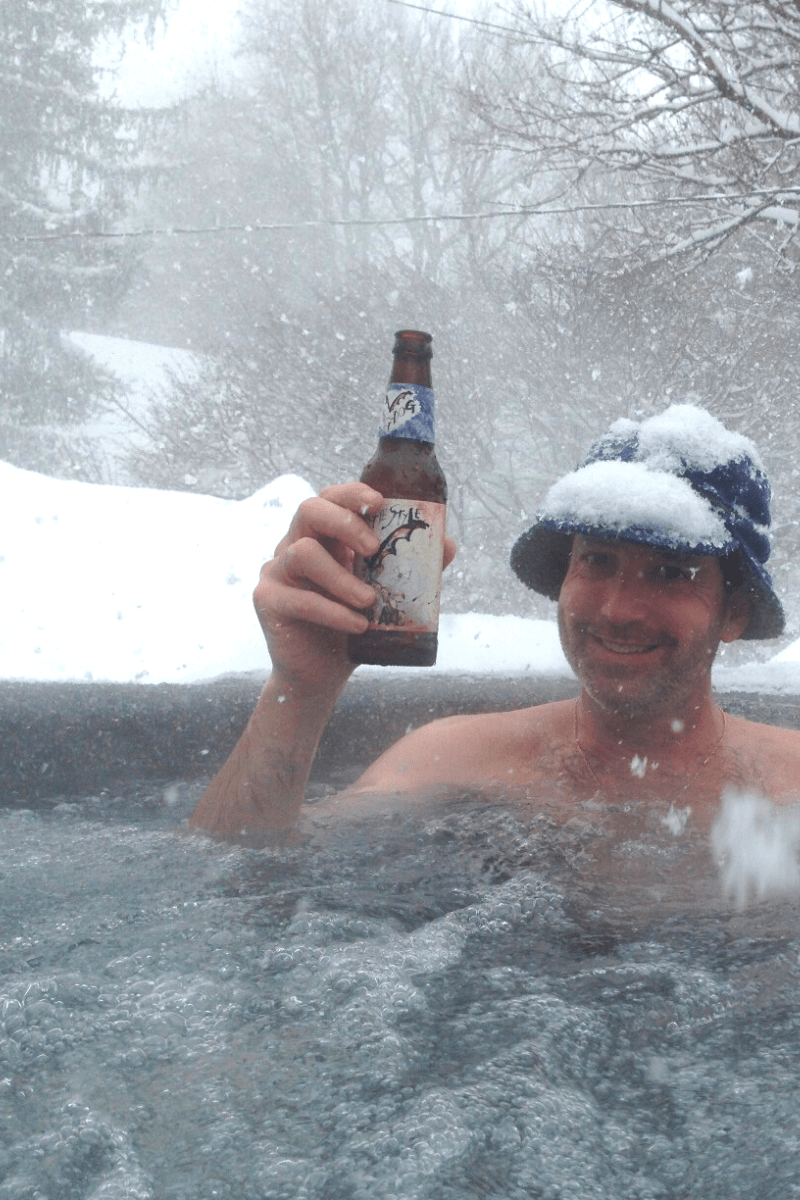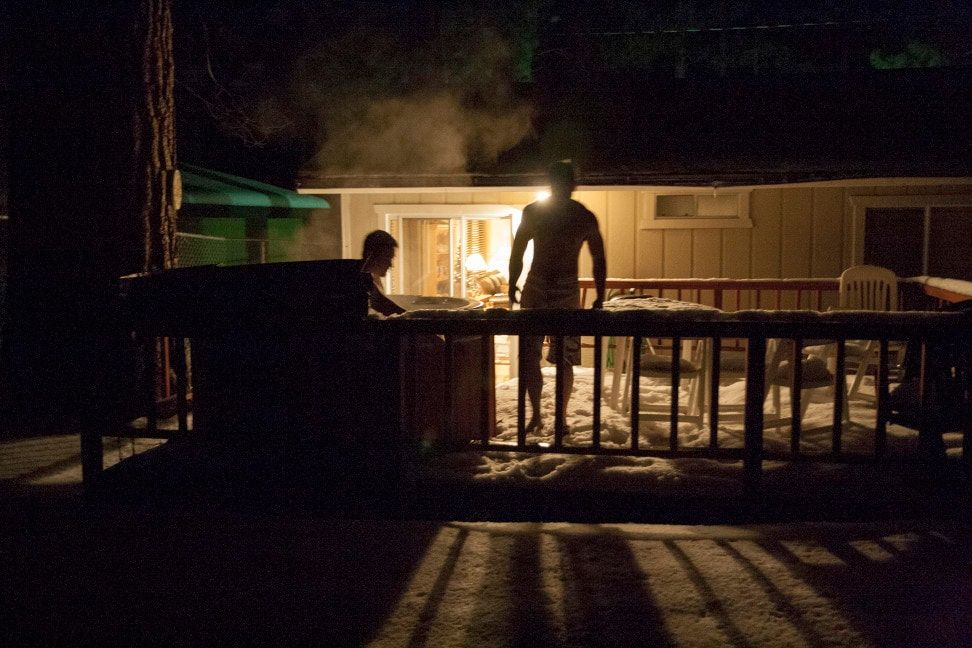The idea of using a hot tub during the winter is a little controversial. Is it bad for your health? Does it use tons of electricity? Won't it leak more? All good questions. The answers are no, it depends, and not if you follow some easy tips. Here is everything you should know about using an outdoor tub even it’s snowing, including cover tips, maintenance, and answers to common winter-hot-tubbing questions.
Using a Hot Tub In Winter
Keeping the Hot Tub Hot
Credit: Aqua Rec
Keeping the water warm during the winter can be done in two different ways (and we recommend that you do both):
Buy a suitable cover. This helps maintain the temperature inside the hot tub as much as possible. A cover can provide proper insulation and do an excellent job of keeping the temperature inside the water at a constant level, but it can’t do wonders. The temperature will still go down; only it will go down at a much slower rate.
Make sure the tub runs. You can set the tub's timer to heat the water for a few minutes at regular intervals to ensure the heat level is constant.
No-Freeze Mode
Freeze protection is super important if you want to take good care of your hot tub. If you bought a modern hot tub, it most likely comes with freeze protection, meaning that the pump activates once the temperature is close to the freezing point. You need to make sure that the product you’re thinking of buying has this feature. Otherwise, you will have to add it yourself.
If you already own a bathtub that doesn’t have a no-freeze mode, you will make sure this problem is avoided by setting the timer on your tub to heat water for about 15 minutes every hour. This will prevent the water inside the hot tub from freezing and keep it circulating through the pipes, which also helps prevent freezing.
Winter Hot Tub Maintenance
There are two different kinds of maintenance processes related to a hot tub: winterization or protecting it if you’re using it during the winter. Winterizations means that if you don’t plan to use your hot tub during the winter, you will have to drain all the water from it and force the water out of the pipes so it doesn’t freeze inside them. If you choose to winterize your spa, you will have to:
- Clean the pipe and the filter of your hot tub.
- Drain your hot tub of water.
- Use either a wet or a dry vac to blow the pipes dry.
- Use a spa cover to protect the hot tub.
However, if you plan to use the spa during the winter, winterization is no longer an option, so the steps you have to take to care of it will change.
- Ensure that you’re using a thick cover that can insulate the tub properly when not in use (we’ll talk more about hot tub covers later in the articles).
- Get a thermal blanket that stays on top of the water’s surface and protect the water in the tub from cold temperatures.
- Keep the water temperature at a constant level, even if that means leaving the hot tub on (this might seem counter-intuitive, but having the hot tub running throughout the winter when you’re using it will do more good than harm).
- Keep a close eye on the water filters to make sure they are clean because if they fail you during the winter, fixing the problem is far more complicated when temperatures outside are freezing.
- Make sure that the pipes don’t freeze.
Winter Hot Tub Leaks
As a hot tub owner, you are very likely to have to deal with leaks at some point, regardless of the season during which you use your hot tub. Finding the leak in time is crucial because not fixing them in time can cause many complications. When it comes to hot tubes, the most common leak sources include the jets, valves, pipe connectors, heaters, and pumps.
Pumps operate at pretty high pressure, so it’s common for water leak past seals with signs of wear and tear. If the seal on a pumping place, you will have to either replace it or have to buy a new pump altogether.
Heaters leak from pressure switches, sensors, or plumbing unions. If you notice any signs of rust on the heater tube, that’s a sign that you’re dealing with a heater leak. Most of the time, solving this problem is simply changing the pressure switch or the union gaskets. If you notice corrosion, you might have to replace the heater assembly.
PVC connections and unions are likely to come loose and leak because they are exposed to constant vibrations and water temperature changes. These leaks can be solved most of the time by hand-tightening the leaking unions or changing the union assembly, the O-ring, or the gasket.
There are three significant valves found on a hot tub: shutoff, air control, and diverter valves. The former and latter types are the ones most likely to leak. If that happens, you can fix the problem by cutting the leaking parts and gluing in new ones.
Credit: Spa Depot
Jet gasket leaks are tricky because they are very similar to a shell leak. Because there is a flexible gasket connecting the jets to the spa shells, hot water will damage these in time, causing the leaks. If this happens, you will have to remove the jets to access the gaskets and replace them with new ones.
Pumps
The pump is considered to be the heart of the hot tub. It is designed with an interior electric motor and a metal shaft coming out of it. This shaft goes all the way to a waterproof chamber, where it flares out into a turbine, very much like blades on a fan. There are two other pipes connected to this same chamber, and the whirlpool generated by the turbine is what draws water from one line and forces it to go through the other. The pump's role is to move the water inside the components of the hot tub for it to be heated for your comfort.
Getting a Good Hot Tub Cover for Winter
Buying a hot tub cover is an essential part of the maintenance process, whether we’re talking about summer, spring, or winter. If you have never bought a hot tub cover before, you might be a little shocked at the relatively high price for something that, you may think, is nothing more than a cover. However, there is more to a hot tub cover than meets the eyes. It’s essential to invest in a cover because:
- they're usually designed with a foam core that’s very dense and does an outstanding job of insulating the hot tub. While there are cheaper options out there that are one tarp that goes over the tub, these foam-block covers are the most efficient ones at protecting the hot tub.
- a tapered cover can allow rainwater to slide right off the surface, making them perfect for all-season use.
When choosing a cover:
- Pay close attention to the hinges. They need to be of high-quality not just for durability reasons but also because they will determine how easy it is to open the cover.
- The vinyl outer cover of the product also needs to take a beating from the elements, especially the snow and sunlight exposure. You also need to consider that the cover's underside will be exposed to hot tub vapors, which means the materials have to be resistant to heat and moisture.
- It is best if you opt for a combination between a hardcover and a seasonal one during the winter months. A seasonal cover is made from tarpaulin and can protect the thermal cover and the hot tub cabinet. That means double the protection.
- Hardcovers are designed to keep debris out of the hot tub, but they are also good at trapping heat inside. There are plenty of hot tubs that are already sold with a hard shell cover, as these products are essential. They'll help you save money on electricity and keep the water inside the hot tub clean.
Wearing Sandals in the Hot Tub
Wearing sandals in the hot tub seems a bit crazy, but if the floor temperature is low, sandals are a perfect idea. You want something to keep your feet warm when you go from the hot tub to the house and vice-versa. Besides, if you were to walk barefooted back and forth, dust, dirt, and debris would get tracked into the hot tub, and nobody can relax in dirty water.
Winter Hot Tub FAQ
Should you leave a hot tub running all the time?
It depends on how often you use your tub and the climate in which you leave. For example, if you live in a cold climate zone, and you use your tub several times a week, leaving it on might be a good idea. However, those of you who have milder winter climates and don’t even use the tub often should turn it off until the next time it will be used. You need to keep in mind that leaving the tub on is inevitably going to consume more energy, but that is the price you will have to pay if you want the water to be warm and ready the moment you want to jump in.
Besides, turning on the hot tub and having it heat the water in the first place consume the most energy. You might have to do some math here and see which of the two options is most cost-effective in your situation. And there is one more thing that you have to keep in mind: if the temperatures drop below the freezing point and your tub is not turned on, there is a chance the water inside it will freeze and damage the tub. In this case, you are better off, leaving the hot tub turned on.
What is the best temperature for a hot tub during the winter?
Again, the answer to this question depends on a series of other variables, with the most important one being the frequency at which you use your hot tub during the winter. Statistically speaking, most people prefer temperatures of 102-104° F. If you’re not using the hot tub but still want to have it ready for next time, it’s best to maintain constant water temperature.
Will it use a lot of electricity in the winter?
If a hot tub uses a lot of electricity or not depends on the quality of the construction. A hot tub that comes with dense insulation, a good cover, and a base pan will not consume a lot of electricity even when the temperatures outside are very low. However, more factors contribute to a hot tub's energy consumption, such as the temperature of the water, the climate in which you live, the prices of your utility company, etc. The main idea is that if you invest in a high-quality hot tub, it shouldn’t consume a lot of electricity during the winter. It might require a larger upfront investment, but it pays back in time.
What to wear in a hot tub in winter?
In general, you can wear pretty much anything that makes you feel comfortable in your winter hot tub. Still, there are a few things that will make your experience better: a cap, facial moisturizer, and sandals. A cap is a great idea because if your hair gets wet and it’s exposed to the harsh outside temperatures, the possible health implications will be dire, and the last thing you want is getting sick. A facial moisturizer is going to keep your skin protected from cold temperatures characteristic of the winter season. Sandals are great because they keep your feet clean and warm as you’re moving back and forth between the house and the hot tub.
Is it bad for your health to go in a hot tub in cold weather?
A hot tub is right for you in so many different ways: from widening your blood vessels to alleviating joint pain. According to WebMD, who listed all the potential risks of using a hot tub, none of the dangers are related to using a hot tub in the winter. Most of the problems they talk about when it comes to hot tubs are related to potential infections and are not indicated during pregnancy or if you have heart disease. However, they recommend that you turn down the heat to about 100° F, especially if you have any underlying medical conditions. Using a hot tub during the winter is perfectly safe, but ensure that once you exit the tub and head straight for the house, you put on a robe or a towel to avoid the temperature shock.
Bottom Line
Plenty of people choose to go to the sauna or soak in a hot tub after a workout. The soothing of the muscles and the blood vessels' expansion helps the body heal faster, not to mention that sitting in the hot tub is just a relaxing experience overall. By following a simple set of rules and guidelines, you too can enjoy a hot tub even when the temperature outside indicates that it might be a better idea to stay inside.

